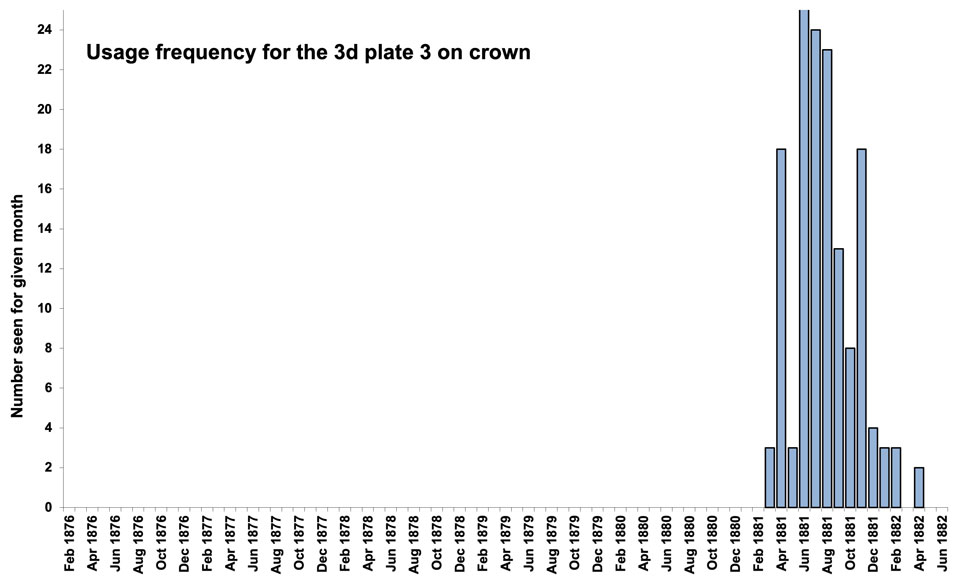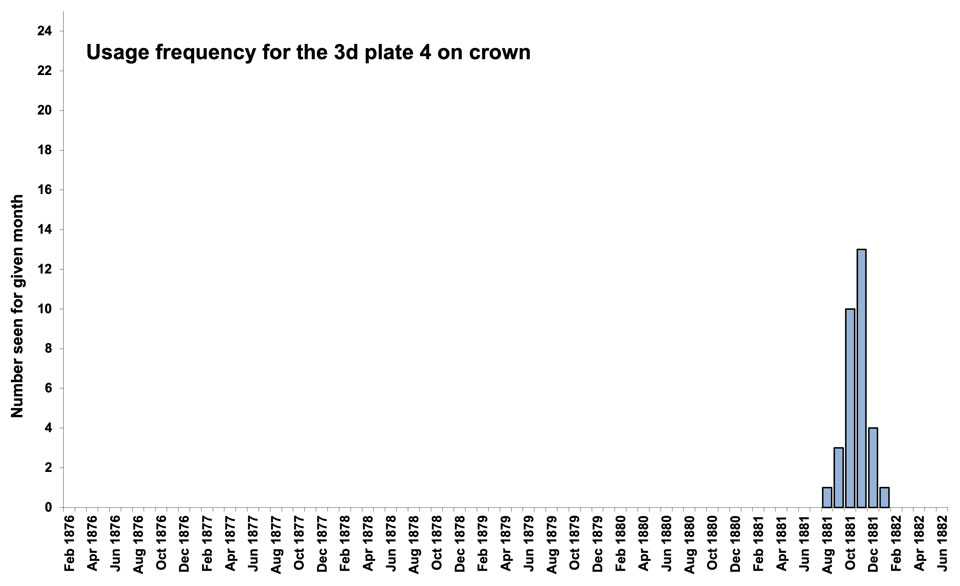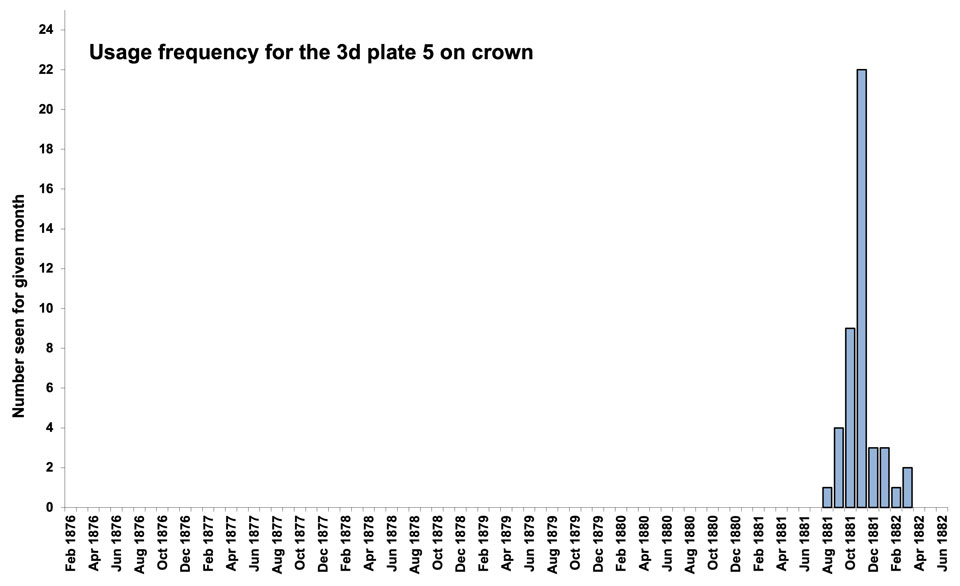1 Essays
2 Die Proofs
3 Sheet Layout
4 Plate Proofs
5 Paper
6 Colour Trials
7 Imprimaturs
8 Colour Standards
9 Specimens
10 Issued Stamps

Date: Mar 1881
Plates: 3-5
Printer: De La Rue
Watermark: Crown (sideways)
Perforation: 14
In 1880 the Post Office decided to use one kind of paper for most standard sized postage and telegraph stamps. Imperial Crown paper was used upright for postage stamps starting with the 1880 “Provisional” issue, and hence sideways for telegraph stamps. The 3d, 6d, 1s, and 3s plates were altered to fit the new layout, and re-registered sheets were endorsed “Proof after alteration of Plate”. Since these were altered plates, there are no essays or die proofs. New telegraph stamps were issued in 1881.
Plate 3 has watermark sideways-inverted (not known to us sideways).
Plates 4 and 5 have watermark sideways (not known to us sideways-inverted).
Sheet Layout
The sheet had 240 stamps in two panes, arranged horizontally. Each pane had 120 stamps in 12 rows of 10. The margins had division ornaments, two hexagons between the panes and two half hexagons in the side margins, marking the division into Post Office sheets of 40 stamps. There were no plate or current numbers. At the middle of each side was a small “T” used as a perforating guide.
A Post Office sheet was 40 stamps, valued at 10 shillings.

Computer generated image, click to enlarge.
Plate Proofs
There are no plate proofs for the altered plates.
Paper
From 1881, plates 3-5 were printed on Crown paper.

The watermark as seen from the front of the stamp.
For more details on Crown paper click here.
Colour Trials



These trials were produced in 1881 at the time plates were being altered for use on Crown paper. They were produced by De La Rue using a 20-stamp plate in response to an issue with the new Crown paper, the watermark was showing through and effecting printing. As such they are paper trials rather than colour trials. A horizontal strip of four and a vertical strip of four of each colour were cut out with scissors, attached to official documents, and overprinted Specimen Type 14. The remaining 12 stamps from each pane are the source of the examples in private hands.
Red represents an institutionalised example.
Green a known example in private hands.
Blue is unknown but predicted by the pattern.

Printed in Blue

Printed in Green

Printed in Orange
| Institutionalised/Total: | 42/60 |
| Royal Philatelic Collection: | DJ, DK(or) |
| British Postal Museum: | AI-DI, EI-EL |
| Tapling Collection: | — |
| Langmead Collection: | AK-BL |
| Phillips Collection: | CJ (bl,or) |
Two strips of four of each colour remain intact: AI-DI, EI-EL.
One corner block of four of each colour remains intact: AK-BL.
There is also a single example in blue, lettered SA, in the Royal Philatelic Collection which has a solid background to the head. It is from the opposing corner of the sheet to the other trials. Maybe TA also exists in a similar form somewhere?

Royal Philatelic Collection.
Reproduced by gracious permission of Her Majesty The Queen to whom copyright belongs.
Imprimaturs



Plate 3 was re-registered on 17 Feb 1881, plates 4 and 5 on 5 Aug 1881.
Each sheet was endorsed “Proof after alteration of Plate.” and
“Ordered that this altered Plate be brought into use.”
The registration sheets for the Telegraphs have been lost. However, we can reconstruct them from known examples and a clear pattern emerges. Most have a column of 12 taken, plus four from the adjacent column, and a plate number example from the opposite corner. One sheet of each value has an extra column of 12 taken.
Plate 3 SD is listed in Langmead and Huggins, but this is a plate proof. Five pairs remain intact: Plate 4 BA-BB, BG-BH, BI-BJ, BK-BL; and Plate 5 TK-TL.
Red represents an institutionalised example.
Green a known example in private hands.
Blue is unknown but predicted by the pattern.

| Institutionalised/Total: | 8/17 |
| Royal Philatelic Collection: | AA, TH |
| British Postal Museum: | SI, SK |
| Tapling Collection: | TK |
| Langmead Collection: | TI |
| Phillips Collection: | TD, TG |

| Institutionalised/Total: | 12/29 |
| Royal Philatelic Collection: | AE, BA-BB, TL |
| British Postal Museum: | KB, KD |
| Tapling Collection: | AB |
| Langmead Collection: | AD, BK-BL |
| Phillips Collection: | AG, BC |

| Institutionalised/Total: | 8/18 |
| Royal Philatelic Collection: | AH, TK-TL |
| British Postal Museum: | KB, LA |
| Tapling Collection: | AA |
| Langmead Collection: | AI |
| Phillips Collection: | AJ |
Colour Standards
There are no 3d colour standards on Crown paper.
Specimens
There are no 3d specimens on Crown paper.
Issued Stamps
Stamps were issued from plates 3, 4, and 5.
The usage frequency graphs show that plate 3 was used from Apr 1881, with plates 4 and 5 being used over shorter periods.
Click the graphs to enlarge.

Plate 3 with a duplex cancel. Plate 4 with a Bristol squared circle. Plate 5 with a duplex and a squared circle.

Pen cancelled with manuscript, probable fiscal usage.

Only 84?,131,154A,1057 “English Station” and 95A,155,224 “Scottish Station” railway numerals are known to us.
Issued Stamps — Plate 3
Plate 3 (current no. 496) was registered on 17 Feb 1881.
Scarcity #14 in mint telegraphs, #24 in used telegraphs.


Mint multiples are scarce with only one strip of three, two blocks of four and a block of 12 known to us.
Used multiples are scarce with 16 pairs, three blocks of four, and a block of six known to us. Most of the pairs and two of the blocks of four are used in Stornoway. The earliest known used example is 12 Mar 1881 at Bristol Telegraph Dept (illustrated).
No upright (sideways) watermarks are known to us. All are sideways-inverted.
Click the images to enlarge.
Issued Stamps — Plate 4
Plate 4 (current no. 541) was registered on 5 Aug 1881.
Scarcity #29 in mint telegraphs, #36 in used telegraphs.


No mint multiples are known to us.
Used stamps are rare. No used multiples are known to us. The earliest known used example is 24 Aug 1881 at the Stock Exchange Glasgow (illustrated).
No inverted watermarks are known to us, but one example was mentioned in a 1960’s Robson Lowe auction. It could have been confusion when it was compared to plate 3, which are all inverted.
Issued Stamps — Plate 5
Plate 5 (current no. 550) was registered on 5 Aug 1881.
Scarcity #25 in mint telegraphs, #34 in used telegraphs.


No mint multiples are known to us. A block of 12 was sold at auction in the early 1900s but it is likely that it was split some time ago.

Used stamps are rare. Three pairs are known to us. The earliest known used example is 1 Sept 1881 at College Green, Dublin.
No inverted watermarks are known to us.






